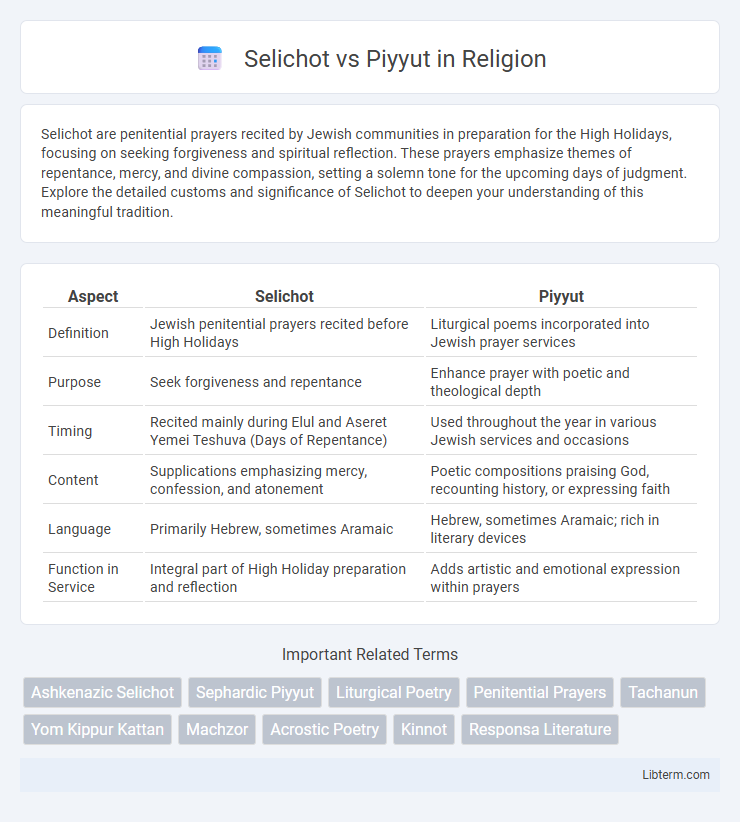Selichot are penitential prayers recited by Jewish communities in preparation for the High Holidays, focusing on seeking forgiveness and spiritual reflection. These prayers emphasize themes of repentance, mercy, and divine compassion, setting a solemn tone for the upcoming days of judgment. Explore the detailed customs and significance of Selichot to deepen your understanding of this meaningful tradition.
Table of Comparison
| Aspect | Selichot | Piyyut |
|---|---|---|
| Definition | Jewish penitential prayers recited before High Holidays | Liturgical poems incorporated into Jewish prayer services |
| Purpose | Seek forgiveness and repentance | Enhance prayer with poetic and theological depth |
| Timing | Recited mainly during Elul and Aseret Yemei Teshuva (Days of Repentance) | Used throughout the year in various Jewish services and occasions |
| Content | Supplications emphasizing mercy, confession, and atonement | Poetic compositions praising God, recounting history, or expressing faith |
| Language | Primarily Hebrew, sometimes Aramaic | Hebrew, sometimes Aramaic; rich in literary devices |
| Function in Service | Integral part of High Holiday preparation and reflection | Adds artistic and emotional expression within prayers |
Introduction to Selichot and Piyyut
Selichot are penitential prayers recited during the High Holy Days and other fasts, embodying themes of repentance and divine mercy within Jewish liturgy. Piyyut refers to a broader category of liturgical poems composed to enhance prayer services, often rich in biblical allusions and poetic structure. While Selichot specifically focus on supplication and forgiveness, Piyyutim serve a diverse range of spiritual and liturgical functions throughout the Jewish calendar.
Historical Origins of Selichot
Selichot originated in early medieval Jewish communities as penitential prayers recited during the High Holy Days, especially between Elul and Yom Kippur, reflecting themes of repentance and divine mercy. These prayers, often collective and structured, evolved from biblical and Talmudic exegesis emphasizing Teshuvah (repentance). In contrast, Piyyut encompasses a broader category of liturgical poems composed since late antiquity, serving diverse ritual purposes across various Jewish rites beyond the penitential scope of Selichot.
Historical Roots of Piyyut
Piyyut, a form of Jewish liturgical poetry originating in late antiquity, emerged primarily in the Land of Israel during the 5th to 7th centuries CE, predating the Selichot prayers that developed in medieval Ashkenaz and Sepharad. These poetic compositions were often infused with biblical allusions and structured to enhance synagogue worship, reflecting the vibrant culture of early Jewish communities. Selichot, by contrast, evolved later as penitential prayers composed mainly for the High Holy Days, emphasizing themes of repentance and divine mercy.
Purpose and Themes: Selichot
Selichot are penitential prayers recited primarily during the High Holy Days period, emphasizing themes of repentance, forgiveness, and divine mercy. Their purpose is to prepare the individual spiritually for Yom Kippur by invoking God's compassion and seeking pardon for sins. The tone of Selichot is solemn and introspective, focusing on self-reflection and communal atonement.
Purpose and Themes: Piyyut
Piyyut are liturgical poems integrated into Jewish prayer services to enhance worship through poetic imagery and thematic depth. They often explore themes of divine praise, historical events, and ethical teachings, elevating the spiritual experience. Unlike Selichot, which focus primarily on penitence and repentance, Piyyut emphasizes celebration and theological reflection.
Liturgical Roles and Usage
Selichot are penitential prayers recited during the High Holy Days season, emphasizing themes of repentance, mercy, and divine forgiveness, primarily used in Ashkenazi and Sephardic traditions to prepare spiritually for Rosh Hashanah and Yom Kippur. Piyyut, a broader category of liturgical poems composed from the 5th to the 13th centuries, enriches Jewish prayer services throughout the year, including Shabbat and festivals, often enhancing the thematic and emotional depth of the prayers. While Selichot's role is specific to penitential contexts and seasonal usage, Piyyutim contribute to the liturgical diversity and artistic expression within multiple prayer settings.
Structural Differences
Selichot are penitential prayers typically composed with a repetitive, acrostic structure that emphasizes confession and supplication, while Piyyut refers to a broader category of liturgical poems with diverse formats ranging from acrostic to rhymed stanzas. The structural design of Selichot often features a formalized, standardized order to facilitate communal recitation during fast days and penitential periods. In contrast, Piyyutim exhibit greater poetic and thematic variety, incorporating intricate metric patterns and elaborate language to enhance synagogue worship beyond penitential contexts.
Musical and Poetic Elements
Selichot are penitential prayers characterized by repetitive, suspenseful melodies that evoke a deep sense of solemnity and introspection, often incorporating traditional cantillation motifs. Piyyut, in contrast, features more elaborate poetic structures with intricate rhyme schemes and meters, accompanied by melodious and varied tunes that emphasize the literary artistry and emotional expression. Both forms utilize dynamic vocal techniques, but Selichot prioritize communal chanting rhythms, while Piyyut highlight melodic embellishments to enhance the poetic narrative.
Prominent Examples and Authors
Selichot are penitential prayers primarily recited during the High Holy Days, with prominent examples including the "Avinu Malkeinu," attributed to Rabbi Akiva and other early authorities. Piyyutim are liturgical poems integrated into Jewish prayer services throughout the year, with notable authors such as Eleazar ben Kalir, whose complex compositions greatly influenced medieval and later Sephardic liturgy. Both genres showcase significant contributions to Jewish religious poetry, reflecting historical, theological, and cultural themes unique to their periods and communities.
Contemporary Relevance and Practice
Selichot are penitential prayers recited primarily during the High Holy Days period, emphasizing themes of repentance and forgiveness, which maintain strong relevance in contemporary Jewish worship as communities seek spiritual renewal. Piyyut, a broader category of liturgical poetry, enriches modern prayer services with historical and poetic expressions that enhance communal participation and cultural identity. Both forms continue to evolve, reflecting current linguistic styles and thematic concerns while preserving their foundational roles in Jewish spiritual life.
Selichot Infographic

 libterm.com
libterm.com